Mala Gallery
8, Zamkowy Sq., Warsaw (Old Town)
4 - 28 January 2005
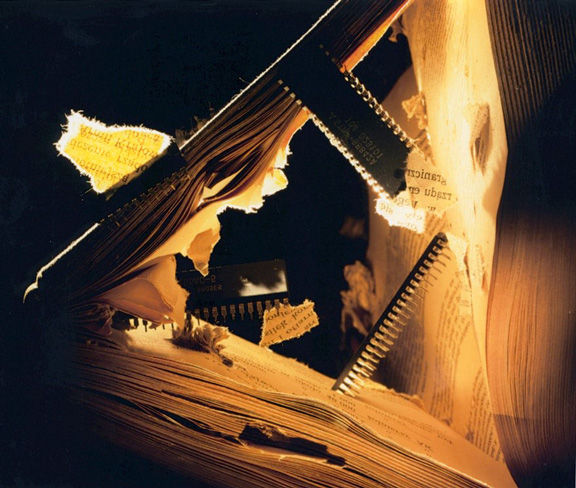
Marek Czarnecki, "Media war", exhibition at Mala Gallery in Warsaw, January 2005
Marek Czarnecki - Media war

MAREK CZARNECKI has staged a war that is being wagged in his own library. Media used up to now for recording and storage of images are beginning to fall into decay after being attacked by computers.
These staged pictures marked by somewhat childish symbolism animate reflection upon how the image comes into being, whether quality and value of particular photograph is determined by employed technology or also, or perhaps foremost, by ingeniousness of individual artists.
Marek Czarnecki attempts with his statement to force back insistent attack of new media and to draw our attention to the fact that now we are witnessing a crossing beyond some tradition of manufacturing the image. Impact of the image can be entirely altered by manipulations that are more and more often carried out - sometimes in a way invisible for the eye - with use of electronic means. Such manipulations can also deprive each picture of its unique character of original.
Still we cannot say what will be result of this invasion of new possibilities of image recording. But it is certain that photography will become more attainable and universal than it was up to now.
And finally a simple question can be posed, the question that has been persistently waiting to be asked: - whether simplicity and availability of producing photographs can influence their quality, whetherin many years from now we'll be coming back to them like we are coming back today to old pictures calling some of them "the works of old masters". It seems like we still have to wait for the answer....
Marek Grygiel
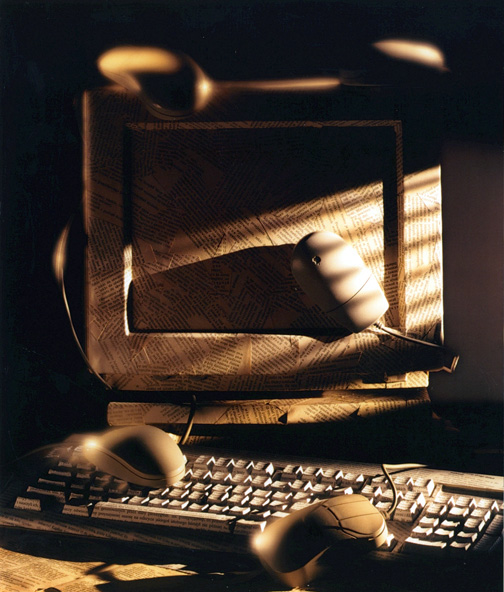
Marek Czarnecki, "Media war", exhibition at Mala Gallery in Warsaw, January 2005
Marek Czarnecki (ur. 1956) fotografią zajmuje się od wielu lat. Mieszka w Toruniu, należy do Związku Polskich Artystów Fotografików, British Institute of Professional Photography. Laureat wielu nagród w dziedzinie fotografii reklamowej. Od lat wykonuje również fotografie eksperymentalne (panoramy), jest laureatem wielu prestiżowych nagród w tej dziedzinie m.in. laureatem Oskara przyznawanej przez MPA w Wielkiej Brytanii. Wydaje albumy autorskie, współpracuje z domami wydawniczymi w Polsce i w Niemczech.
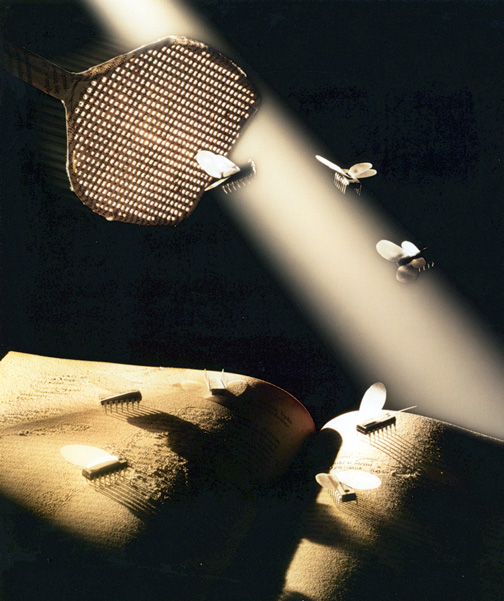
Marek Czarnecki, "Media war", exhibition at Mala Gallery in Warsaw, January 2005
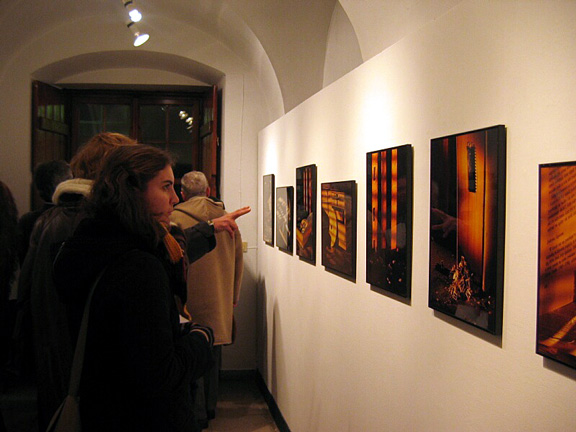
Opening of Marek Czarnecki's exhibition at Mala Gallery in Warsaw, January 4th, 2005. Photo Adam Mazur..
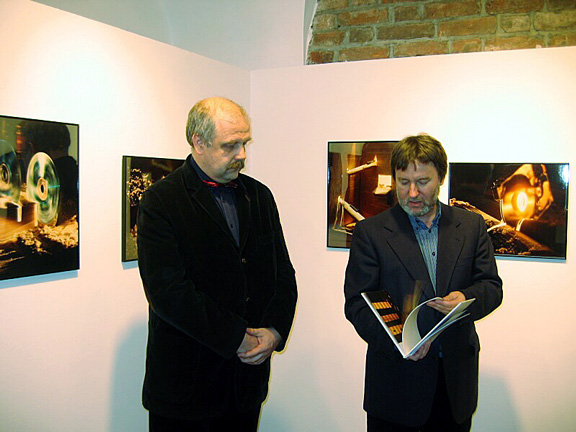
Autor Marek Czarnecki (left) during opening party for his exhibition "Media War" at Mala Gallery, Warsaw, January 4th, 2005. Photo Adam Mazur.
See also:
In FOTOTAPETA also:
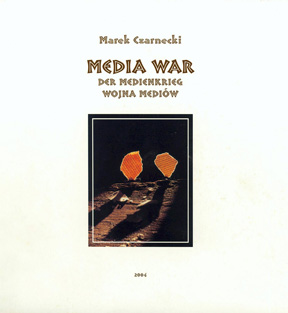
Marek Czarnecki - "Media War"
publisher: ateFOKA, 2004
www.atefoka.com.pl
ISBN 83-918844-9-X
PHOTOGRAPHY has started its third century of existence. It has proved to be an independent domain of the arts and a way of recording the world around us, as well as the feelings and emotions generated by our imagination.
The masters of light obtained better and better materials and equipment to register pictures through the development of techniques and technology. Picture recording on film has been always at the centre of public attention, but there was only one supremely important object - the original. The original was the completed expression of the author’s idea, and it was invaluable. It could be multiplied, but copies, although frequently the best that techniques allowed, were still only copies not quite originals.
The phenomenon of recent years has been the creation of better and better tools to overcome the deficiencies of the older ones. Scientific and technical progress contributed, to a large extent, to the elimination of differences between the original and its copy. Furthermore, we can now assemble, perhaps in the same computer, as many originals and copies as we want, each of which can be considered as a new original. A super tool was made available which gave unlimited potential for creation, and thereby partly eliminated the author’s exclusive control over a picture. It allowed everybody to bring something new to a picture, and at the same time create a new original.
Being brought up in respect for the masterpiece and its author, but also taking advantage of modern techniques and technology, I revolted against all these wonderful modern achievements. I realised that although widening and facilitating work, they very frequently deprive the author of control, by incorporating the author’s work as part of a series of operations to create a target picture, which constitutes the sum of many other pictures or manipulations.
Increasingly, more and more authors become more and more anonymous and take only a share in the final form of the piece of work, which may have a number of different original sources and many not-quite-identical copies existing simultaneously.
This caused an artistic revolt in me. Modern media became the subject of adoration, but also hatred on behalf of the author. Therefore, I instigated a series of photos, which present in an artistic manner the destruction carried out by the modern media (i.e. electronics) on the older media which have served to transfer information and pictures on printed paper. The war which I created in my imagination is waged in the library. It is as ruthless as life is, where manufacturers of paper, paints and printing machines fight a deadly battle with the content of the internet on millions of hard discs throughout the world. In our everyday life, we print things less and less often on a computer printer, and we absorb information directly from the screen, not knowing and not pondering whether what we are studying is the original or a copy, how many originals can be found in the world at the same time, or who is the author of everything we see.
Of course, when photography was new, the painters, who were the picture creators of that time, did not treat it seriously, saying that it only registered the world around us in a mechanical manner without having any creative or artistic features. Currently, nobody treats the new media lightly. They have won the recognition of picture creators, although many artists keep to classical, traditional techniques of making pictures.
However, we can notice that photography is more and more frequently only the beginning of the creation of a final picture. Photographers for whom the camera itself turned out to be insufficient, and where the optical perspective, which all of us apply, became the main limitation of their creative workshop, are the authors of these pictures.
Only free transformation of a picture made it possible to realise the author’s idea and imagination.
At the same time, artists who dealt in the graphic arts noticed the force of photography, and made it work for them, commonly using photographs in their pictures; but I would like to emphasize that the ease of access to new tools for picture making does not always guarantee artistic success.
Aesthetics are not easily classified and are not subject to changes by the flexible new tools for picture-making. Emotions which overcome us when we look at works which are characterized by simplicity, but at the same time reflect the author’s style, suggest that the final appearance of a piece of work is what is always assessed, much more than the means of producing it.
It is worth highlighting that we live in the period of breakthroughs, and ‘tomorrow’ may appear before we expect it, anticipating even the most daring forecasts. What we might expect to be real in a hundred years, may appear in a few years or even months.
In this text, I would like to draw your attention to the author and his role in the creation of pictures. We need to remember that behind every picture, there is a person, its author. Notwithstanding the number of originals created at the same time, he will always be the author.
The success of the classical media in their fight against the new ones could happen only in the arts, and not in reality, where progress in the creation of new techniques and technologies takes place quicker and quicker, independently of the intention and will of artists, but frequently with their active participation. It is only a reflection of the author’s personal feelings and emotions, when the author himself is a modernity fan, and actually has had a formal education as a technician for the new media – he was an electronics designer. He has hesitated for a moment and dreamed, and his hesitations and dreams are presented in the form of a picture cycle whose content could be based on facts or be exclusively an artistic vision of the author, slightly tired of becoming acquainted with the potential of new media and their importunate attack.
Marek Czarnecki
Copyright © 1997-2025 Marek Grygiel / Copyright for www edition © 1997-2025 Zeta-Media Inc.